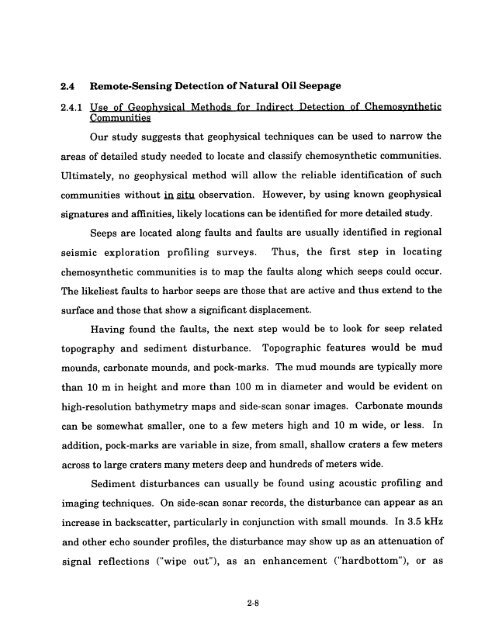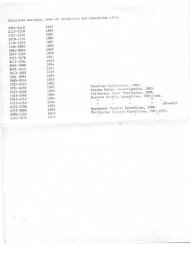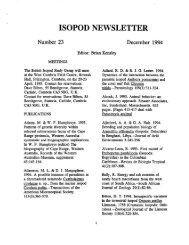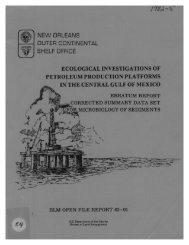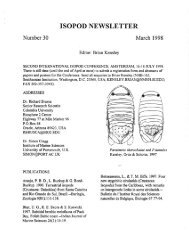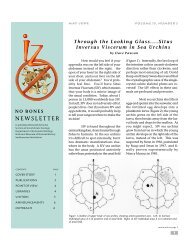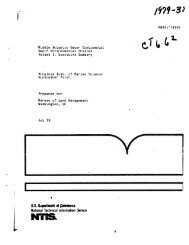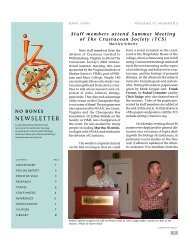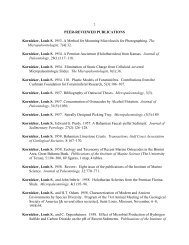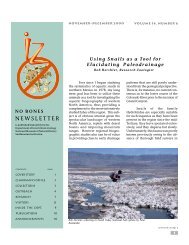- Page 1 and 2: OCS StudyMMS 95-0022Northern Gulf o
- Page 3 and 4: DISCLAIMER.This report was prepared
- Page 5 and 6: Principal Investigators (*) and Ass
- Page 7 and 8: 3 .5 .1 Acoustic Echo Types . . . .
- Page 9 and 10: 6 .6 Gulf-Wide Patterns . . . . . .
- Page 11 and 12: LIST OF FIGURESFigurePage2.1 Locati
- Page 13 and 14: 5 .3 Relation between wet weight an
- Page 15 and 16: 8 .25 The apportionment of paleoing
- Page 17 and 18: 6 .4 Composition of upper and lower
- Page 19 and 20: y diverse, but tiny burrowing anima
- Page 21 and 22: Collectively, these sites were judg
- Page 23 and 24: 2.0 The Regional Distribution of Ch
- Page 25 and 26: estricted to the localized areas wh
- Page 27 and 28: 981W 96°W 94°W 92°W 90°W 88°W
- Page 29: of exploration; the envelope of occ
- Page 33 and 34: The Space Shuttle photograph was sc
- Page 35 and 36: 53 27043.62' N 91026.19'W GC0230 82
- Page 37 and 38: Sites selected for dives were locat
- Page 39 and 40: Oil floating on the sea degrades as
- Page 41 and 42: When Y, the dimensionless crossplum
- Page 43 and 44: Figure 2.3 Laser line scan image co
- Page 45 and 46: 3.0 Geological and Geophysical Char
- Page 47 and 48: 51'wgaysz4ow 9?20W 9TiQYY MOW 9190V
- Page 49 and 50: with active salt movement and activ
- Page 51 and 52: nodules (Behrens 1988) .This may al
- Page 53 and 54: tracks suggests that for most of th
- Page 55 and 56: each site .The paper side-scan reco
- Page 57 and 58: Table 3.2 Description of push cores
- Page 59 and 60: ::~ v^{TYPE 1~s ate`' ~~,;~v.F .r.,
- Page 61 and 62: carbonate rock(diameter 410 cm)ligh
- Page 63 and 64: eflector at this location may have
- Page 65 and 66: Figure 3 .7 . Patterns of acoustic
- Page 67 and 68: WNwFigure 3.9 Patterns of acoustic
- Page 69 and 70: GC 234, which has no large mound st
- Page 71 and 72: WNfigure 3.11 Side scan sonar mosai
- Page 73 and 74: 0 201'45"NWNCDFigure 3 .13 Comparis
- Page 75 and 76: 3 .5 .5 Connections to Deep FaultsI
- Page 77 and 78: our data on the locations of chemos
- Page 79 and 80: seen or turbidity (reverberation) w
- Page 81 and 82:
continuous layers beneath the GB 38
- Page 83 and 84:
4.0 Geochemical Alteration of Hydro
- Page 85 and 86:
A fundamental feature of the chemic
- Page 87 and 88:
98OC 70`~ o 0 GC-272 (CF)x GC-2340
- Page 89 and 90:
86o GC-272 (CF)x GC-234o Bush Hillf
- Page 91 and 92:
0-5 cmN~1 .0 m3-15 cm^'C4 / i'C4 va
- Page 93 and 94:
0-3cm1 .0 m 0.13-11 cm11 - 25 cm" P
- Page 95 and 96:
4.2 Experimental4.2 .1 SamplesSampl
- Page 97 and 98:
approximately 575 m .The clams cont
- Page 99 and 100:
Table 4 .1Concentrations of UCM (pp
- Page 101 and 102:
cCFigure 4.11 Examples of C15. chro
- Page 103 and 104:
ange . The i-C4/n-C4 ratios varied
- Page 105 and 106:
3AvcasQas2NWmtrolTotal Cj-CS (PPm)
- Page 107 and 108:
GC 185-2 Seep SampleNCnNAL OXDA110N
- Page 109 and 110:
at GC 185 was higher (24,775 ppm) t
- Page 111 and 112:
The C15+ chromatograms of sediment
- Page 113 and 114:
'PwFigure 4.17 . A C 15+ chromatogr
- Page 115 and 116:
were destroyed by bacterial oxidati
- Page 117 and 118:
3 . Sediment samples from an area w
- Page 119 and 120:
their chemical habitats, we also de
- Page 121 and 122:
samplers employ stainless steel fil
- Page 123 and 124:
Marked mussels were retrieved in Au
- Page 125 and 126:
5.5 Statistical MethodsDue to the n
- Page 127 and 128:
6% with another 40% accounted for b
- Page 129 and 130:
lamellibrachids and eight escarpids
- Page 131 and 132:
varied from extremes of 1 .4 to 22.
- Page 133 and 134:
Table 5 .2 Variability in replicate
- Page 135 and 136:
5 .7 .3 Vectimentiferan Condition a
- Page 137 and 138:
For each of the other three conditi
- Page 139 and 140:
(Rosman et al .1987) and while they
- Page 141 and 142:
Table 5 .6 Sulfide levels in Louisi
- Page 143 and 144:
Table 5 .7 Methane concentrations i
- Page 145 and 146:
1008060d 402000 20 40 60 80 100 120
- Page 147 and 148:
5 .9.2 SM Ia Population StructureTh
- Page 149 and 150:
Table 5.8 Average growth rate of SM
- Page 151 and 152:
s4.,0 o =O 0000oO ~NNUM~M~N~NIpM~NM
- Page 153 and 154:
5.9 .4 growth Rates and Ages of SM
- Page 155 and 156:
live a long time after reaching rep
- Page 157 and 158:
65s*r43JC1,= 0U-1-240 50 60 70 80 9
- Page 159 and 160:
Mean shell lengths of mussels from
- Page 161 and 162:
the effects on condition and growth
- Page 163 and 164:
ed oxidation rates necessary to sus
- Page 165 and 166:
6.0 Sessile Macrofauna and Megafaun
- Page 167 and 168:
common axis .Under ideal conditions
- Page 169 and 170:
Table 6 .1 Continued3265 .04 08/09/
- Page 171 and 172:
articulated dead shells with no liv
- Page 173 and 174:
6.3.3 relationships With Provanna s
- Page 175 and 176:
species complex form the primary bi
- Page 177 and 178:
developmental stage or not .A compr
- Page 179 and 180:
organisms in the seep environment .
- Page 181 and 182:
Although Aluinocaris stczc tophilia
- Page 183 and 184:
however, the bathymetric range of s
- Page 185 and 186:
Table 6 .4Continued .ECHINODERMSAst
- Page 187 and 188:
changes bathymetrically, geographic
- Page 189 and 190:
might trip the balance in populatio
- Page 191 and 192:
typical chemosynthetic fauna at eac
- Page 193 and 194:
parent image . Rotation, etc . was
- Page 195 and 196:
Table 7.2 .Classifications of commu
- Page 197 and 198:
sections, and the remaining sides c
- Page 199 and 200:
mechanical arm of NR-1 and was left
- Page 201 and 202:
photomosaics encompassed a total of
- Page 203 and 204:
Grid M . 1 . Tm2 . Msb3 . M-dGrid N
- Page 205 and 206:
7 .3 .5 Photomosaics at GC 272 : Si
- Page 207 and 208:
designated labeled A through F . Fe
- Page 209 and 210:
7 .4.2 GC 234A single cage was depl
- Page 211 and 212:
marker . Between 1991 and 1992, thi
- Page 213 and 214:
15th .Comparison of photographs and
- Page 215 and 216:
408 .535V3071NU°... 8.0aEt' 7.5V1V
- Page 217 and 218:
concentrations of dissolved methane
- Page 219 and 220:
On a larger scale, submarine observ
- Page 221 and 222:
fauna, the rods in the brine have e
- Page 223 and 224:
a matter for speculation, but clear
- Page 225 and 226:
8.0 Evidence for Temporal Change at
- Page 227 and 228:
where B is biomass-at-death in g as
- Page 229 and 230:
ased on consideration of the locati
- Page 231 and 232:
were alive .The degree to which thi
- Page 233 and 234:
Lucinid biofades-coat slopeLucfnotn
- Page 235 and 236:
A .Lucinoma n .Vesicomya cordLucino
- Page 237 and 238:
Following taphonomy, the guild stru
- Page 239 and 240:
Ludnid biotaclea-cont.slope120lbyss
- Page 241 and 242:
the size classes were redefined acc
- Page 243 and 244:
Paleoproduction by biofaciesFigure
- Page 245 and 246:
appearance for paleoingestion becau
- Page 247 and 248:
Paleoproduction by biofacieslou9pe0
- Page 249 and 250:
containing the remains of much olde
- Page 251 and 252:
in its size-frequency composition .
- Page 253 and 254:
Paleoproduction by biofacies1009080
- Page 255 and 256:
Numerical abundance by biofaciesFig
- Page 257 and 258:
Paleoingestion by biofaciesip090806
- Page 259 and 260:
contribution to tier structure, whe
- Page 261 and 262:
GC-184 Lacinid biofictes12(Y1GC-234
- Page 263 and 264:
Numerical abundance by core interva
- Page 265 and 266:
Paleoingestion by core intervalloo9
- Page 267 and 268:
Paleoproduction by core intervalloo
- Page 269 and 270:
8.28 with Figure 8 .25 for example)
- Page 271 and 272:
top of the core . In-between, epifa
- Page 273 and 274:
GC-184 Core 1Lucinid biofacies05101
- Page 275 and 276:
272 was nearly identical to that ob
- Page 277 and 278:
paleoproduction and paleoingestion,
- Page 279 and 280:
diameter piston cores were taken in
- Page 281 and 282:
ange of conditions from distinctly
- Page 283 and 284:
habitat was invariantly suboptimal,
- Page 285 and 286:
Guild and tier structure varied lit
- Page 287 and 288:
Faunal succession was not observed
- Page 289 and 290:
Recovery times are simply too long
- Page 291 and 292:
Table 9 .1 Seep sites from which oc
- Page 293 and 294:
Figure 9.1Major bands and minor ban
- Page 295 and 296:
Figure 9 .2Cross section of axial r
- Page 297 and 298:
colonies and one male colony were o
- Page 299 and 300:
LS =rFigure 9 .4Rows of maturing sp
- Page 301 and 302:
2000 = GC 234 NE 1991t = VK 828 199
- Page 303 and 304:
One-way ANOVA's were performed to d
- Page 305 and 306:
= FEMALE COLONIES0 = MALE COLONIESw
- Page 307 and 308:
spawning event by these geographica
- Page 309 and 310:
10.0 An Ecological Characterization
- Page 311 and 312:
otherwise overlain by a less fractu
- Page 313 and 314:
lower concentrations of hydrocarbon
- Page 315 and 316:
10 .1 .6 Temporal ChangeThe paleont
- Page 317 and 318:
original resolution .A modest level
- Page 319 and 320:
in a format that would augment the
- Page 321 and 322:
11.0 Literature CitedAllen, A.A .,
- Page 323 and 324:
Cavanaugh, C .M ., S.L . Gardiner,
- Page 325 and 326:
A. Newton, M .A . Powell, G .N . So
- Page 327 and 328:
Jackson, M.P.A . and C .J . Talbot
- Page 329 and 330:
MacDonald, I .R ., N.L . Guinasso,
- Page 331 and 332:
Rosman, I ., G.S . Boland, and J.S
- Page 333 and 334:
Tunnicliffe,V . 1992 . The nature a
- Page 335:
~Q S~,ENT OF Ty ~The Department of


